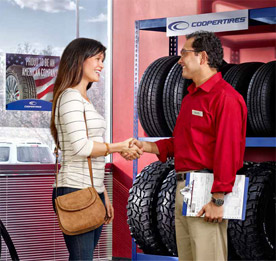Tire Solution: The Influence of Climate Problems
When it pertains to making sure optimum performance and safety and security on the roadway, comprehending the influence of weather problems on tire solution is crucial. From scorching warmth to icy roadways, each weather component can considerably affect tire capability and total driving experience. By diving right into the effects of varying weather condition problems on tires, drivers can gain useful understandings that may improve their car's efficiency and longevity. In this discussion, we will explore the intricate connection between weather problems and tire service, clarifying the relevance of weather-specific tire upkeep practices and factors to consider.
Heat and Tire Performance
When revealed to high temperature levels, tires experience changes in efficiency that can substantially affect vehicle safety and security and handling. The warm generated from prolonged driving or warm weather problems causes the tire rubber to soften, leading to reduced step life and boosted wear.
In addition, high temperature levels can accelerate the process of tire aging, triggering the rubber to wear away more promptly. To reduce the impacts of warmth on tire efficiency, drivers must routinely inspect their tire pressure, turn tires to make sure also put on, and check for any type of indications of damages.
Winter Effects
Cold weather condition conditions can have a significant influence on tire performance and safety and security. In chilly weather condition, tires may additionally shed air pressure more swiftly, which can influence managing and fuel efficiency.
To mitigate the results of chilly weather on tires, it is critical to routinely check tire stress and inflate them to the producer's recommended levels. Utilizing winter season or all-season tires designed for winter conditions can also boost traction and grip on icy or snowy roadways - tire shop morris. Appropriate tire maintenance, consisting of routine inspections for wear and damages, comes to be also much more critical during cooler months to guarantee ideal efficiency and safety and security
Rainy Conditions Influence
Tires with damaged treads are much more prone to hydroplaning, where a layer of water constructs up in between the road and the tire surface area, leading to loss of grip. To combat this, drivers ought to consistently evaluate their tires for appropriate tread deepness and take into consideration spending in tires particularly designed for damp conditions.

Snow and Tire Safety And Security
Snow-covered roads pose special challenges for motorists, emphasizing the value of proper tire option and maintenance. When driving in snowy conditions, having the appropriate tires can make a significant distinction in safety and efficiency. Winter tires are developed with unique rubber substances and tread patterns to give better grip on snow and ice contrasted to all-season tires. The much deeper treads and sipes of wintertime tires help hold the roadway much better, reducing the risk of sliding and slipping.
Along with utilizing wintertime tires, it is important to guarantee they are properly inflated. Winter can cause tire pressure to go down, influencing traction and handling (morris tire and alignment). Regularly checking and keeping the correct tire pressure is essential for ideal efficiency in snowy problems

Weather-Related Tire Maintenance
When faced with different weather conditions, correct tire maintenance becomes a vital aspect of automobile safety and performance. Weather-related tire upkeep incorporates a variety of methods targeted at ensuring ideal tire feature and durability in different weather condition circumstances. One key element of weather-related tire upkeep is tire pressure regulation. Changing temperature levels can cause tire pressure to vary, impacting traction and click here to read fuel performance. Frequently readjusting and examining tire pressure according to producer suggestions is essential for secure driving in transforming climate condition. Furthermore, tire walk deepness plays a significant role in dealing with various weather condition components. Tires with appropriate walk deepness give better grip on wet or icy roadways, reducing the risk of skidding or hydroplaning. Examining tire walk on a regular basis and changing tires when tread wear reaches a certain deepness is essential for keeping grip and stability in unfavorable weather condition. By focusing on weather-related tire upkeep, chauffeurs can look at this now enhance safety and security, enhance vehicle efficiency, and lengthen the life expectancy of their tires.
Verdict
To conclude, weather have a substantial effect on tire efficiency and security. From warmth impacting tire pressure and put on to winter decreasing grip, it is important to consider the weather condition when maintaining and making use of tires. Stormy problems can lower hold and bring about hydroplaning, while snow can enhance the threat of crashes if tires are not appropriately geared up. Weather-related tire upkeep is crucial in making sure optimal efficiency and safety and security when driving.
In this discussion, we will explore the intricate connection in between climate conditions and tire service, shedding light on the significance of weather-specific tire maintenance methods and considerations.

Comments on “Specialist Morris Tire and Alignment: Boost Your Automobile's Efficiency”